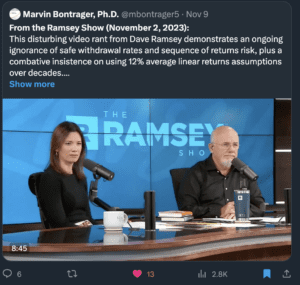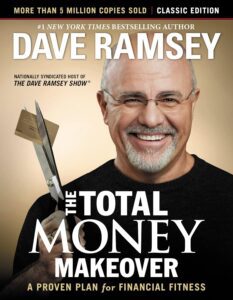The Great Retirement Withdrawal Rate Debate : And why Dave Ramsey Is Wrong
Many people dream of the day when they will retire. There aren’t many topics as polarising in the personal finance world as that of retirement. This week a Dave Ramsey video got the whole Finance Twiitter world in a spin.
Table of Contents
ToggleWhen should you retire? How much do you need to retire? Is it possible to retire early? When should you start saving for retirement and how do you go about planning for it?
How do you ensure that you don’t need to rely on your family or even worse, the government, to get by in your later years?
What will your quality of life be like after you stop working?
The Usual Retirement Plan
The conventional path that most people have trod for decades has been a pretty set-in-stone formula. You get a job, work for 40-50 years, put away enough savings throughout your lifetime and stop working to enjoy your autumn years at around 65 (if you’re lucky).
Depending upon which country you are in, you may have been helped along the way with retirement and investment schemes. And maybe even a government pension awaits you when you reach some magic age.
Most of us want to be prepared sufficiently to support ourselves with a high quality of life when we eventually decide that we’ve worked long enough. Nobody wants to rely on policies, support or pension schemes that could change
Alternate Approaches
Some people have suggested that it is possible to follow an alternate path such as the FIRE movement (Financial Independence Retire Early). In this scenario extreme frugalism and savvy index fund investing can get you out of your dead-end job earlier. The internet is full of stories of those who have retired in their thirties. One person that I have followed is Canadian-born blogger Peter Adeney (known as Mr. Money Mustache)
Or the idea of relocating to lower-cost-of-living countries (Geographic arbitrage) to get more value for your buck. Perhaps taking mini-retirements overseas or even year-long sabbaticals to pursue other opportunities. The digital nomad trend has also emphasised the benefits of relocation.
Or even the thought that it may be possible to create enough passive income and to work part-time with online businesses. This may allow you to continue to earn well past traditional retirement age.
Why do we have to retire at all if we can find something profitable that we enjoy?
It’s a great time to look at alternative pathways to retirement and I love considering any alternative other than the standard of simply working until you reach a certain age.
The Magic Number
How much do you need to retire? If we just move away from the idea of a magic age such as 65 then we can look at other indicators of when might be the right time to retire. Instead of retirement age, we can aim for a retirement amount in terms of the actual amount that you need to have saved and invested to be able to stop working.
If you can reach this number, then you could be able to quit work regardless of your age.
This ‘magic number’ is the source of much debate and is indirectly the topic of this blog article. This number varies greatly depending upon your desired living standard, the country that you are in and of course the performance of your investments.
Finance Twitter Goes Crazy Over Dave
This week saw Finance Twitter (X) go crazy with comments, discussion, debate and much mocking related to a Dave Ramsey video. The video included Ramsey’s views on exactly how much can ‘safely’ be withdrawn from retirement accounts without depleting retirement funds over the long term.
For example, if you have $1 million saved, how much can you safely withdraw each year without risking running out of money while you are still alive? (let’s say 30 years of living expenses)
Who Is Dave Ramsey?
Dave Ramsey is an American radio personality who offers financial advice. He hosts the nationally syndicated radio program The Ramsey Show. Ramsey has written several books, including The New York Times bestseller The Total Money Makeover‘. He is known for his 7 steps that guide people from eliminating debt to financial independence.
It has often been said by other financial advisors that these steps are great for helping people who have struggled with debt to improve their circumstances. However, there is considerable doubt as to whether these methods maximise wealth for those with a better understanding of financial matters. Now it seems there is more doubt about the plan concerning retirement.
That Video
We saw some pretty amazing claims in this video. These came when a podcast caller pondered over whether withdrawing 4-5% annually was safe or if in fact, 3% was a better plan. This caused Ramsey to launch into a rant that claimed the following:
- An 8% withdrawal rate was actually fine
- That we can expect a 12% return on our retirement funds each year based on the S&P 500
- That for most years his own fund has performed at far higher than 12%
- That a $1m fund will create an $80,000 income forever
- That those who advocate for a 4% withdrawal rate are ‘morons’
So let’s break this down a little by firstly explaining the basis of the generally accepted 4% rule that you may have heard of.
Here Is How The 4% Rule Works
In 1994, financial advisor William Bengen published a paper titled Determining Withdrawal Rates Using Historical Data— in the Journal of Financial Planning. Bengen found that retirees could safely spend about 4% of their retirement savings in the first year of retirement. In subsequent years, they could adjust the annual withdrawals by the rate of inflation.
Following this simple formula, Bengen found that most retirement portfolios would last at least 30 years. In many cases, the portfolios remained intact for 50 years or more. This is keeping in mind the historical performance of the stock market where retirement savings would be invested in lower-risk index funds as well as some percentage of bonds.
The 4% rule is easy to follow. In the first year of retirement, you can withdraw up to 4% of your portfolio’s value. If you have $1 million saved for retirement, for example, you could spend $40,000 in the first year of retirement following the 4% rule.
Beginning in year two of retirement, you adjust this amount by the rate of inflation. If inflation were 2%, for example, you could withdraw $40,800 ($40,000 x 1.02). In year three, you’d take the prior year’s allowed withdrawal, and then adjust that amount for inflation.
Asset Allocation
After testing various asset allocations, Bengen adopted the assumption that a retiree’s portfolio would be invested 50% in stocks (the S&P 500) and 50% in bonds (intermediate-term Treasuries). Using this asset allocation, he tested a range of first-year withdrawal rates:
- 3% withdrawal rate: All portfolios lasted 50 years.
- 4% withdrawal rate: Most portfolios lasted 50 years. Retirements started in 10 of the 50 years examined fell short of this mark, although they all lasted about 35 years or longer.
- 5% withdrawal rate: More than half of the portfolios were exhausted in less than 50 years, with the worst portfolios lasting no more than about 20 years.
- 6% withdrawal rate: Only seven portfolios lasted 50 years, with about 10 lasting fewer than 20 years.
Hence Dave Ramsey’s advice that it is safe to withdraw 8% each year flies in the face of such recommendations from experts such as Bengen.
The Reaction
Twitter ( I still call it Twitter) went into meltdown in response to Ramsey’s advice to his caller. Many accounts pointed out that the S&P doesn’t go up by 12% every year. They also proposed scenarios when a retiree could suffer losses in the early years of retirement that would be devastating at a withdrawal rate of 8%.
Though the S&P may average 10% or even 12% over certain periods of history, it has also fallen over long periods. If the timing of retirement aligns with a decline in the stock market, a 4% withdrawal allows for more to be left in the fund to grow when eventually the market rebounds as it has done in the past. An 8% rate could be disastrous.
One financial analyst Rob Berger provides a good reaction in his YouTube video that I have linked here. He provides modelling that suggests very high failure rates using Ramsey’s 8% figure.
Rob Berger video link https://www.youtube.com/watch?v=CkasQp3TeXM
Why Dave Is Wrong
Though this topic can lead one down the path of using data, modelling and complicated scenarios to suggest a financial strategy, I’ll keep things simple. The real fear associated with an 8% withdrawal rate is that if the market falls for any considerable amount of time, the fund could be depleted before it has a chance to rebound. Ramsey’s scenario which he argued passionately for assumes that a retirement fund will earn 12% in the first year of retirement and will continue to do so for 30 years.
He claims that a person with $1 million can withdraw $80,000 each year and that the fund will even continue to grow. His biggest complaint about the so-called ‘morons’ advising a 4% withdrawal rate (some even are starting to suggest that 3% is better) is that it makes people believe that they need twice as much in order to retire.
Of course, many factors will affect exactly how much you need. Perhaps you will have other sources of income (such as rentals or an online business) or perhaps your cost of living will fall as you age.
Many people find that they have very few fixed costs in retirement as they may have a paid-off home and car. Hence expenses are lower.
In A Nutshell
I’ve followed this debate for the last couple of days. I am yet to find anyone agreeing with the majority of Dave Ramsey’s rant. I’ve also found several other Dave Ramsey videos where he says that he is very comfortable recommending a withdrawal rate of 8%.
In each case, he refers to market returns of 11-12%. Going against this advice is that the majority of investors are advised by other experts to rebalance investment portfolios to include bonds. Conventional advice is to have a portfolio consisting of 50-60% bonds by retirement age to insulate against market volatility.
Final Thoughts
There are many great resources out there that offer more credible advice in this area than I believe Dave Ramsey is offering. I would stick with the majority view and consider that 4% should be followed.
But I would also suggest that as we are all living longer, we should pursue opportunities to keep earning in ways other than just through retirement funds. I’m personally planning to never completely retire. However, I would like to transition to part-time work (is that semi-retirement?) by the time I reach 60.
The positive thing is that this debate reminds us all that we do need a plan. And the earlier that we start our plan, the better off we will be. If your plan gets you to a magic number in your thirties, forties or fifties then that’s awesome.
And when you get bored, you can always go back to work. The beauty of finding financial independence is not that you get to sit on a beach for 30 years. It’s that you get to choose how you want to spend your time. And that’s something that we can all aspire to, in our own way and regardless of the numbers.
Related articles:
All You Really Need To Know About The Stock Market








Excellent article! I appreciate the thorough and thoughtful approach you took. For more details and related content, here’s a helpful link: LEARN MORE. Can’t wait to see the discussion unfold!